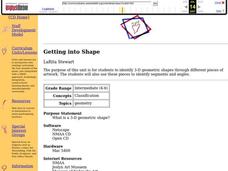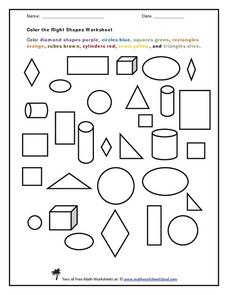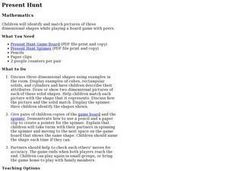Curated OER
3-D Figures Part 1
Elementary schoolers explore 3-D shapes. They transition from thinking of shapes as only 2-D. Pupils read Cinderella as a launching activity for their upcoming adventure, and explore a new world of 3-D shapes in this introductory lesson.
Curated OER
Getting into Shape
Students identify 3-D geometric shapes through different pieces of artwork. They examine and identify segments and angles. Students act out shapes and create a piece of artwork. Additional cross curriculum activities are listed.
Curated OER
Color the Right Shapes
I remember doing this activity when I was little. Learners color each shape the color indicated at the top of the page. Squares are blue, cubes are red, circles are green and so on. There are 30 shapes to identify and color.
Curated OER
2-Dimensional Shapes: Naming Shapes
Get to know eight shapes by name: square, rectangle, triangle, pentagon, hexagon, and octagon. Young geometers write the correct name below each of these shapes, using a word bank for guidance. Then, they draw two of the...
K-5 Math Teaching Resources
Mini Math Word Wall
Provide a little extra support for your emerging mathematicians with a personal word wall. Including graphics and images that support children with learning to count, identify colors and shapes, and read high frequency words,...
Curated OER
Three- and Two- Dimensional Geometry
In this three- and two- dimensional geometry worksheet, 7th graders solve 12 various problems related to geometric shapes and measurement. They first use paper and a pencil to sketch the front, side, back, top and bottom views of each...
Curated OER
Shape Hunt
Young scholars explore two-dimensional and solid shapes. In this shapes and patterns geometry lesson, students work with a partner to create identifiable objects using tangrams. Young scholars describe the attributes of their shape and...
Curated OER
Compare 2-D Shapes
Second graders examine the attributes of two-dimensional shapes. In this geometry lesson plan, 2nd graders play a game in order to identify two-dimensional shapes and to name them.
Curated OER
3-D Figures Part 2
Students work with three dimensional objects. In this geometry lesson, students examine models of spheres, cones, cubes, prisms, and pyramids, and identify them by their edges, vertices, and faces.
Curated OER
Present Hunt
Students identify and match pictures of three dimensional shapes while playing a board game with peers. They take turns with their partners in spinning the spinner and moving to the next space on the game board that shows the same shape.
Curated OER
Using Geometric Shapes in Architecture
Third graders identify two and three dimensional shapes used in architectural designs by viewing images on the Internet. For this geometry lesson, 3rd graders create their own building designs and identify the geometric shapes that...
Curated OER
Blocks in a Sock
First graders identify geometric solids. In this shapes and solids beginning geometry lesson, 1st graders reach into a bag and identify the geometric solid they feel. Students describe shape attributes and match two dimensional shapes to...
Curated OER
Using 2 and 3 Dimensional Geometric Shapes
Pupils explore geometry by participating in a shape identification activity. In this figure dimensions instructional activity, students identify the difference between 2 and 3 dimensional shapes by their vertices and faces. Pupils...
Curated OER
Identify Polygons: Algebra/Geometry Institute
Eighth graders classify geometric figures. In this polygon lesson, 8th graders identify given geometric figures. They compare and contrast different polygons. Students name line segments, identify parallel lines, and...
Curated OER
Corners and Sides
In this corners and sides worksheet, learners, with a partner, explore and calculate the answers to six word problems that involve a variety of different geometric shapes.
Curated OER
Marshmallow Geometry
In this three-dimensional shapes geometry lesson, learners identify geometric solids and name their properties. They define "face," "edge," and "vertex," and construct geometric solids using marshmallows as vertices and toothpicks as edges.
Curated OER
Making a Six-pointed Star
In this polygon worksheet, students identify and create a six-pointed star by completing 6 steps. First, they use a compass to trace a circle with a given radius. Then, students draw a point on circumference of the circle and place the...
Curated OER
Symmetry Worksheet IV
Challenge your class to identify, label, and draw a wide range of symmetries with this worksheet. In addition, learners name symmetrical shapes and compare them to alphabet letters. This worksheet asks class members to work with lines of...
Curated OER
Three Dimensional Figures
In this geometry worksheet, students study diagrams with labels of common geometric figures. Students then answer 24 questions. Then they draw and label their own figures.
Curated OER
Recognize Triangles
In this shapes worksheet, learners are asked to "colour" all of the triangles they find on the page. There are 10 shapes on the page and 4 are triangles. The second page contains suggestions for teachers on activities with 2-D shapes.
Curated OER
Polynominoes
In this polynominoes worksheet, learners solve 9 different types of polynominoes problems. First, they identify that a polynominoe is a polygon made from squares of the same size and connected to each square. Then, students determine how...
Curated OER
Identify Solid Shapes
In this solid shapes worksheet, students name and describe the solid shapes on the left. Students color the objects that are like the solid shape.
Curated OER
Geometric Solids
First graders identify various shapes in everyday objects. in pairs, 1st graders go on a shape field trip to locate various objects of different shapes. They photograph the objects and later use the prints to write sentences describing...
Curated OER
Problem Solving Using Power Polygons
Students investigate geometric shapes by creating figures on a plane. In this polygon lesson, students complete a worksheet based on the angles in a power polygon. Students identify the different types of polygons and define their...























